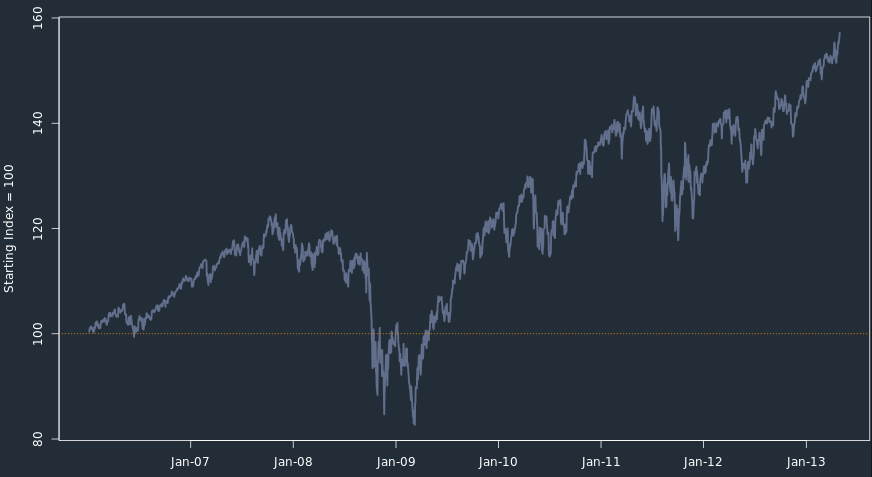PersonalCapital.com in addition to a nice user interface also offer portfolio management (ie managed money). This is aimed at the “mass affluent” segment, which for the sake of a definition would likely be people with a liquid net worth from around 250k to $5million+. They also seem to be trying to capture up and coming HENRYs (high earners not rich yet). In finance industry slang this would be somewhere in between poor people (<100k) and ultra high net worth (>$10million). They are correct that this segment is traditionally underserved by common brokerages. Typically their minimum account size is 100k (but you can negotiate for less). They do charge a 0.95% annual fee (prorated and deducted monthly) for the privilege – but please read on before going into DIY mode!
Personal Capital are a small firm and are looking to grow so if you want a relationship that isn’t “generic brokerage” they seem to able to provide that (in our limited experience of them). They can also do web presentations online and conf calls around your schedule, which was convenient and efficient.
We are using with a portion of our “sensible” money and they have recently implemented a “Moderate” portfolio for us. If you back test this “Moderate” portfolio for the last 6 years it has beaten market cap weighted indexes such as SPY (see chart). So it does appear to have some secret sauce. PersonalCapital only publish performance numbers from 2011 onwards, but we have back tested ourselves through the credit crisis and found their current “Moderate” portfolio to perform like this:
Their strategy broadly speaking is they buy stocks and etfs on equal weighting (not market cap weight) across domestic and international markets. All international or fixed income exposure is done with ETFs. All domestic equity exposure is with individual stocks. We aren’t going to give the full strategy (not fair to them as we paid them for it), but at a high level it has these asset classes:
US stocks: equal weight the “best 6” stocks in each major sector as determined by personal capital research (about 1% portfolio in each stock)
US fixed income: buy fixed income ETFs : e.g. JNK
International equity exposure: ETFs : e.g. SCHF
International fixed income exposure: ETFs : e.g. IGOV
REITs: ETFs : e.g. VNQ
Commodity: ETFs : e.g. DBC, IAU
(some of the commodity ETFs are questionable long term holdings due to contango issues)
Portfolio yield on April 2013 was 2.3% (Moderate) and 2.6% (Conservative) – so not much difference.
Strategy advantages
– Tax loss selling – you own the individual stock yourself so can sell appropriate at year end to harvest tax losses (and they manage this for you)
– Portfolio transparency – you can see exactly what you own in your own Pershing brokerage account (but you don’t manage it). One nice feature is that even though it is a managed account, if you wanted to take over your portfolio management yourself in future you could directly transfer all holdings back to your current brokerage account.
– Restricted list – you can define stocks or sectors that you do NOT want to invest in (not sure how much customisation is available here, but it was definitely offered)
-Fully managed account – can be totally hands off or you can have some active involvement (you can influence asset allocation/sector decision making).
– Outperformed their ETF market cap weighted benchmark by 3.2% in 2012 (excluding fees, so really 2.15%). Performance is shown net of fees and reflects the reinvestment of interest and dividends. Scroll to the end of their performance page for small print on how this was calculated.
Disadvantages
– it is standard Modern Portfolio Theory fare with no hedging. They don’t think option strategies “add value”.
– Although backtesting indicates outperformance versus a performance, this is no future guarantee and the fees could be a drag on future performance.
– Not sure how comprehensive their benchmarking is. For example they don’t seem to benchmark against Alternatives, but their Aggressive portfolio can be up to 12% alternatives. From their performance page “None of the benchmarks used include any component for alternative investments. Personal Strategies will more easily exceed benchmark performance to the extent alternative investments perform better than the index components.”
Summary
Asset diversification can reduce overall portfolio risk, but does not eliminate tail risk. Personal capital is not a thorough risk tool, in our opinion you should combine it with risk analyser such as Portfolio Defense or use your own hedging strategy.
Based on our back tested, this appears to be a slightly better way to gain exposure to stocks than market cap weighted ETFs. However it still suffers from the major drawdown impact of 2008 which absolute return strategies seek to avoid.
We like personal capital money managed version of a diversified portfolio but we hedge it with SPY options using portfolio defense or own methods to try and find the optimal hedge.
Verdict
Time will tell – we like the transparency and the backtested results. We don’t like the fees, and you could definitely argue that you could easily run this strategy yourself and rebalance once a quarter (and not pay out the fee). There is definitely a “convenience” factor which you pay for. However it does give you confidence that someone is managing your money *transparently* in a way you can at least understand (definitely not a black box). Good for a relatively passive portfolio strategy, but we would always hedge any portfolio they produce (but that’s just our philosophy).

One thought on “Personal Capital Portfolio”